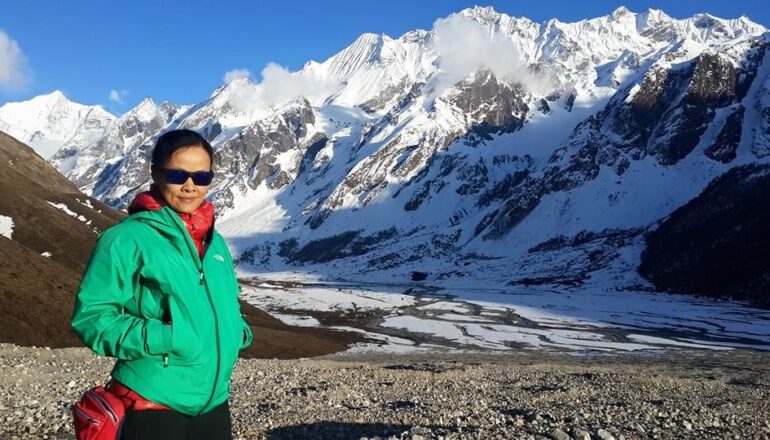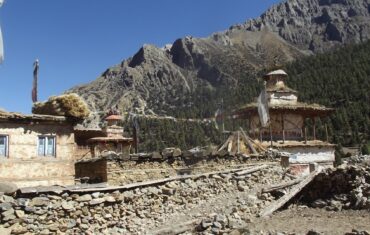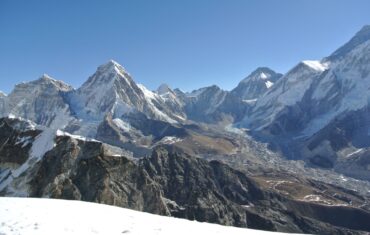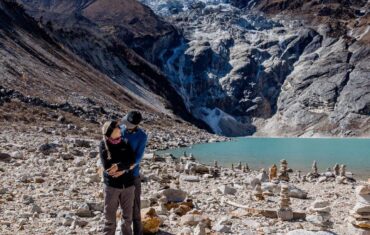Introduction: Langtang Valley Trek
Nestled in the heart of the majestic Himalayas, the Langtang Valley trek promises a breathtaking journey through pristine landscapes, charming villages, and awe-inspiring mountain vistas. Join me as I recount the unforgettable experiences of my recent trek to this hidden gem of Nepal.
The adventure begins in the bustling capital city of Kathmandu, where anticipation and excitement fill the air. After a scenic drive through winding roads, we arrived in Syabrubesi, the starting point of our trek. The village welcomed us with warmth, and we spent the evening acclimatizing to the altitude, readying ourselves for the days ahead.
The trail led us through dense rhododendron forests, the air filled with the melody of chirping birds. As we ascended, the views of the Langtang mountain range became more prominent. Our overnight stay at Lama Hotel provided a cozy refuge amidst the wilderness, surrounded by the serenity of nature.
Today’s trek brought us to the picturesque Langtang Village, a charming settlement with colorful prayer flags fluttering in the mountain breeze. We explored the local monastery, immersing ourselves in the rich culture and traditions of the Tamang people who call this region home.
The highlight of the trek was undoubtedly reaching Kyanjin Gompa, a high-altitude village with panoramic views of snow-capped peaks. Surrounded by glaciers and soaring mountains, the tranquility of Kyanjin Gompa was a surreal experience. We took a day to acclimatize and explored the nearby viewpoints.
Our determination led us to the summit of Tserko Ri, where the sunrise painted the Himalayan peaks in hues of gold and pink. The 360-degree views left us in awe, with Langtang Lirung, Dorje Lakpa, and the Ganesh Himal range standing tall in all their glory.
As we descended back towards Syabrubesi, we reflected on the incredible journey we had undertaken. The memories of the friendly locals, the challenging yet rewarding trails, and the sheer majesty of the Langtang Valley will forever be etched in our hearts.
Do’s:
- Acclimatize Properly:
- Spend a day acclimatizing in key villages like Lama Hotel and Langtang Village to minimize the risk of altitude sickness.
- Pack Appropriately:
- Bring sturdy, comfortable hiking boots and layers of clothing suitable for varying weather conditions.
- Respect Local Customs:
- Respect the local culture and traditions. If unsure, observe and follow the lead of the locals.
- Contribute to Local Economy:
- Support local businesses by buying goods and services from the communities along the trek. This helps sustain the local economy.
- Use Teahouses Responsibly:
- Choose teahouses that prioritize responsible and sustainable practices. Conserve resources such as water and electricity.
- Pack Out Your Trash:
- Carry a small bag for your trash and dispose of it properly at designated places. Leave no trace behind.
- Follow Trekking Permits:
- Ensure you have the required permits for the Langtang National Park and display them as needed.
- Stay Informed:
- Stay updated on weather conditions and trail information. Be prepared to alter your plans if necessary for safety reasons.
- Interact with Locals:
- Engage with the local communities, learn about their way of life, and show appreciation for their hospitality.
Don’ts:
- Don’t Rush Acclimatization:
- Avoid ascending too rapidly. Take the time to acclimatize properly to reduce the risk of altitude-related illnesses.
- Don’t Disturb Wildlife:
- Refrain from disturbing or feeding wildlife.
- Don’t Litter:
- Never litter on the trail. Carry your trash with you until you find proper disposal facilities.
- Don’t Ignore Altitude Symptoms:
- If experiencing symptoms of altitude sickness, such as headaches or dizziness, don’t ignore them.
- Don’t Bargain Unfairly:
- While bargaining is common in local markets, avoid unfair haggling. Remember that your purchases contribute to the livelihoods of the locals.
- Don’t Stray from Marked Trails:
- Stick to marked trails to avoid getting lost and disturbing fragile ecosystems.
- Don’t Overburden Descend to a lower altitude if necessary.Porters:
- If hiring porters, don’t overload them. Ensure their well-being and fair treatment.
- Don’t Disturb Monasteries:
- When visiting monasteries or religious sites, maintain a quiet and respectful demeanor.
- Don’t Forget Travel Insurance:
- Don’t embark on the trek without adequate travel insurance. It’s crucial for emergencies and unforeseen circumstances.
By adhering to these do’s and don’ts, you contribute to the sustainability of the Langtang Valley trek and ensure a positive impact on both the environment and local communities.
Included:
- Trekking Permits:
- The cost of necessary trekking permits for Langtang National Park is usually included.
- Accommodations:
- Accommodations in teahouses or lodges along the trekking route are often included.
- Meals:
- Most packages include meals (breakfast, lunch, and dinner) during the trek.
- Guide and Porter:
- A licensed trekking guide and, in some cases, a porter to carry a portion of your load. The guide provides information about the trail, local culture, and ensures your safety.
- Transportation:
- Transportation from Kathmandu to the trek starting point (usually Syabrubesi) and back is often included.
- Welcome and Farewell Dinners:
- Some packages include welcome and farewell dinners in Kathmandu.
- Trekking Gear:
- Some trekking companies provide basic trekking gear like sleeping bags and down jackets.
- Medical Kit:
- A basic medical kit is usually provided for emergencies.
Excluded:
- International and Domestic Flights:
- The cost of flights to and from Nepal, as well as any domestic flights within Nepal, is typically not included.
- Personal Expenses:
- Expenses such as additional meals, snacks, drinks, and personal items are generally not included.
- Travel Insurance:
- Travel insurance, including coverage for emergency evacuation and medical expenses, is usually not included but is highly recommended.
- Tips and Gratuities:
- Tips for guides, porters, and other staff are not usually included in the package price.
- Optional Activities:
- Any optional side trips, activities, or excursions not mentioned in the itinerary are usually at an additional cost.
- Additional Permits:
- Permits for side trips or extensions beyond the standard Langtang Valley trek may not be included.
- Visa Fees:
- The cost of obtaining a visa for Nepal is typically not included.
- Emergency Expenses:
- Any unforeseen expenses, such as emergency evacuation or additional accommodation due to unforeseen circumstances, are generally not included.
It’s crucial to carefully review the inclusions and exclusions of the trekking package you’re considering to ensure that it meets your expectations and requirements. Additionally, communicate with the trekking company to clarify any uncertainties and to get a comprehensive understanding of what is covered in the package.
Langtang Valley Trek Itinerary: 8 Days
Day 1: Arrival in Kathmandu
- Attend a trek briefing and meet your guide.
Day 2: Drive to Syabrubesi
- Take a scenic drive from Kathmandu to Syabrubesi, the starting point of the trek.
- Get acclimatized and explore the village.
Day 3: Trek to Lama Hotel
- Begin the trek through rhododendron forests and small villages.
- Reach Lama Hotel, a cozy stop for the night.
- Trek to Kyanjin Gompa, a high-altitude village.
- Enjoy panoramic views of the Langtang range.
- Acclimatization day with optional hikes around the village.
- Overnight stay in Kyanjin Gompa.
Day 6: Summit Tserko Ri
- Early morning hike to Tserko Ri for sunrise views.
- Witness breathtaking 360-degree mountain panoramas.
- Descend to Kyanjin Gompa.
- Overnight stay in Kyanjin Gompa.
- Retrace your steps through Langtang Village.
- Overnight stay in Lama Hotel.
Day 8: Trek to Syabrubesi and Drive to Kathmandu
- Final trekking day back to Syabrubesi.
- Drive back to Kathmandu.
- Overnight stay in Kathmandu.
Day 9: Departure
- Leisure day in Kathmandu for additional sightseeing or shopping.
- Departure from Kathmandu.
This is a condensed 8-day itinerary, and it’s important to note that acclimatization days are crucial for your well-being. Adjustments to the itinerary may be made to ensure proper acclimatization and enjoyment of the trek. Always check with your trekking company for the most up-to-date and customized itinerary based on your preferences and conditions on the trail.
You can check out more contents at this link https://www.actual-adventure.com/
For further reading check out our blogs on other Treks over here. https://nepaltrekkingtrail.com/manaslu-region/
Conclusion
The Langtang Valley trek is a testament to the beauty of the Himalayas and the resilience of the local communities that thrive in this remote paradise. If you’re seeking an adventure that combines natural wonders with cultural richness, this trek should undoubtedly be on your bucket list







